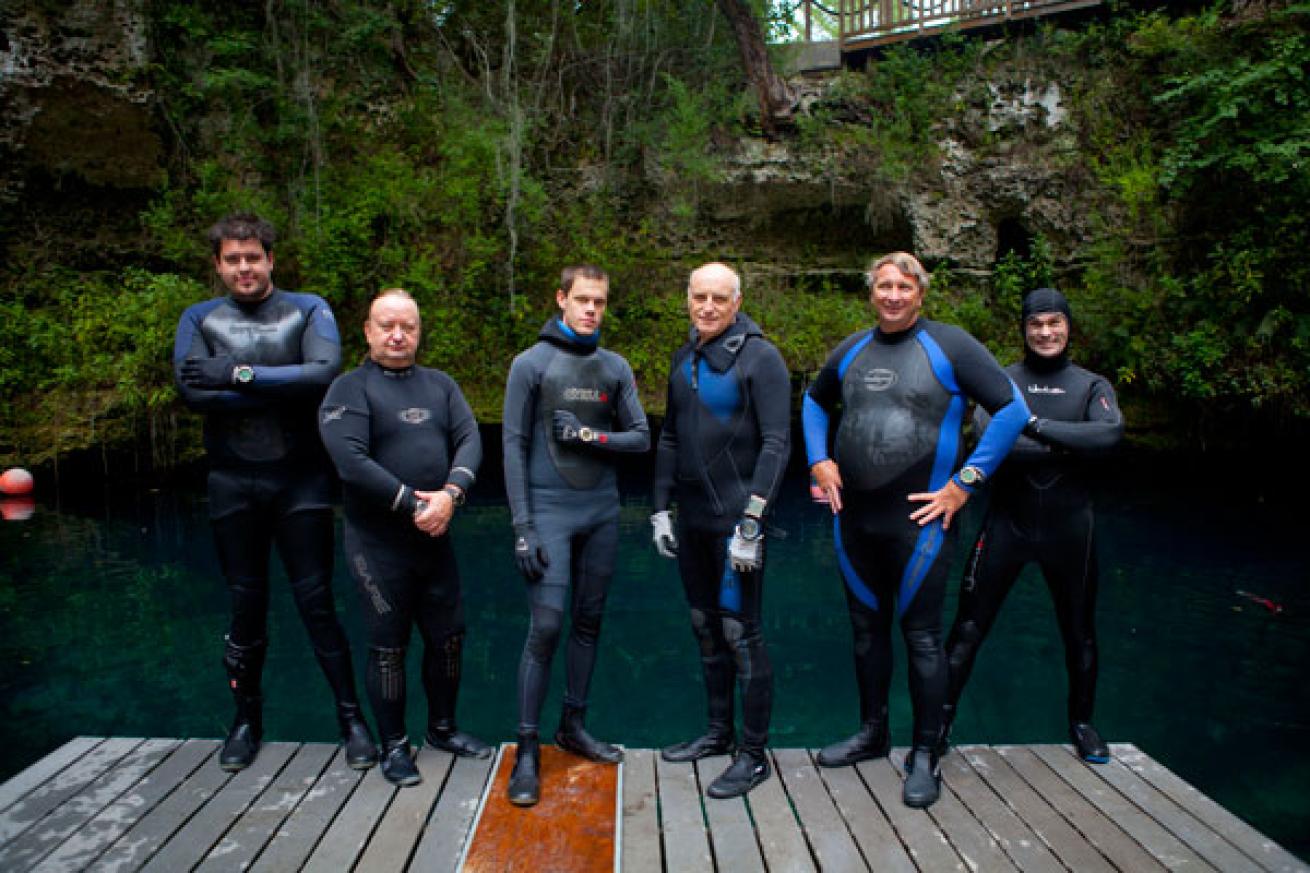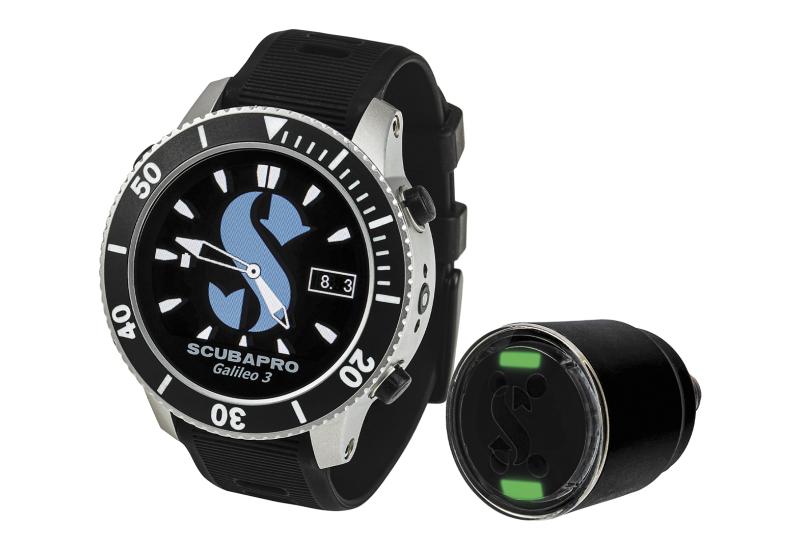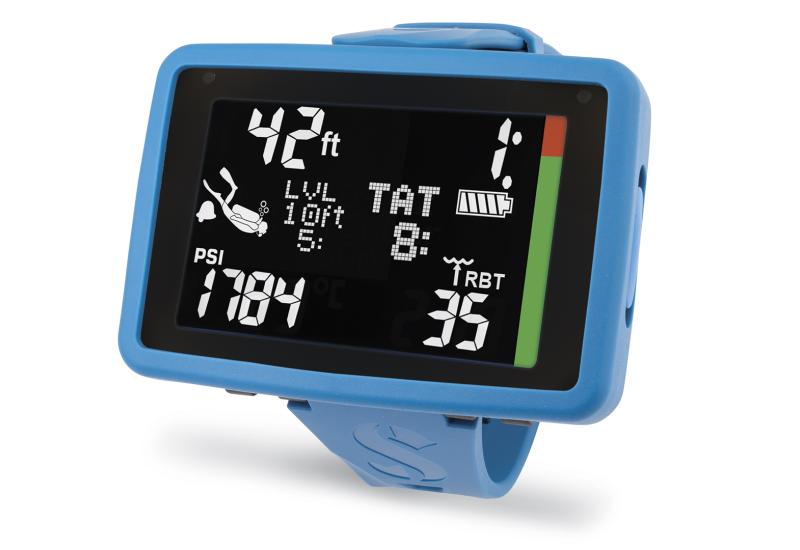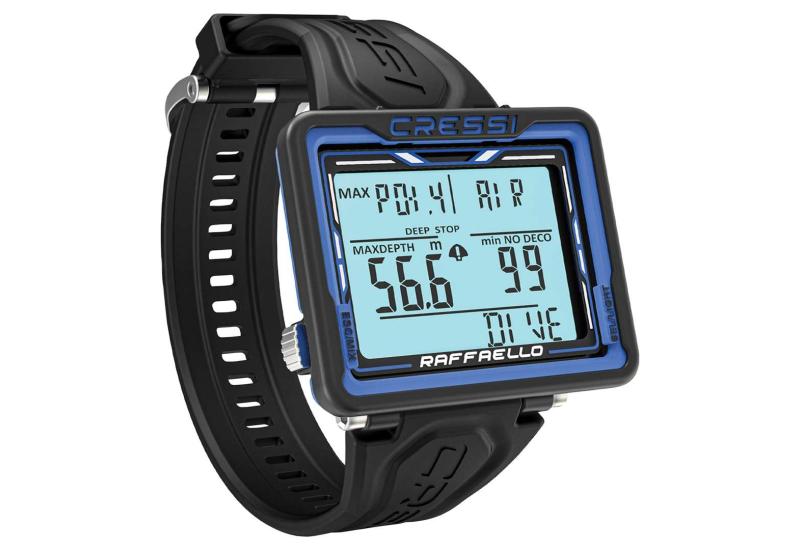ScubaLab Blog: Dive Computers

ScubaLab Test Team, Blue Grotto
Courtney Michalik
2011 DIVE COMPUTER TESTS
Photography by Courtney Michalik and Floyd Devine
While regulator testing is the most technically challenging and BC testing is arguably the most fun, dive computer tests are a gearhead’s most anticipated evaluation. The thought of playing with the dive industry’s latest and greatest digital technology was enough to make our test team salivate in anticipation. Unlike the logistical challenges posed by bulky BCs, all of the dive computers for this year’s primary testing were wrist models that easily fit into an airline carry-on bag, with enough room left over for a week’s worth of personal items — something I was very appreciative of as the testing progressed.
Dry Tests
As with all of our ScubaLab evaluations, we began the testing by putting each computer through our “dry” examination process. Owner’s manuals and online data were examined to find out what the manufacturers wanted us to know about their product, and then we began putting things on and pushing buttons to get a feel for the operation of the device and to become familiar with the individual data displays and menus. This also provided us the opportunity to contact manufacturers with any questions or problems before the computer was subjected to our in-depth testing procedure. While we did not receive any consoles from the manufacturers, several models were modular systems that could be purchased as either a wrist unit or mounted in a traditional console (some of the computers are pictured at right).
manufacturers with any questions or problems before the computer was subjected to our in-depth testing procedure. While we did not receive any consoles from the manufacturers, several models were modular systems that could be purchased as either a wrist unit or mounted in a traditional console (some of the computers are pictured at right).
Going Back to Cali
Once satisfied with the dry testing, the computers were packed into my handy carry-on bag and flown to California for pressure testing in the USC Catalina Hyperbaric Chamber at the USC Wrigley Marine Science Center on Catalina Island (see the photo below, on the right). After the long cross-country flight and ferry ride out to Catalina, the computers were placed inside a wet tank in the hyperbaric chamber and taken on four different “dives” that are designed to simulate a busy day on a live-aboard dive trip.
Use of the hyperbaric chamber allows us to simultaneously test all the computers at precisely controlled depths and times to obtain the most accurate comparison of No-Decompression Limits (NDL) and depth indications. The two days of chamber testing completed, everything was packed back into my carry-on, and I began the long trip back to Florida, with one quick stop at Disneyland to conduct an informal comparison of West Coast Mickey versus the Orlando variety.
variety.
The Blue Grotto
Having completely pressurized the computers in a laboratory-type setting, we tabulated results and made lots of colorful graphs to compare the NDLs of the various computers and prepare for the final phase of our testing. For the subjective tests, we returned to our favorite Central Florida dive hole, Blue Grotto in Williston. Gathering a dedicated group of dive-gear fanatics, we loaded up a rental pick-up truck with a day’s worth of snacks, energy drinks and enriched air and headed north. At the Grotto, the test team compared the computers in a diverse range of ergonomic factors, including ease of reading the display, effectiveness of backlighting, and simplicity of the menus and alternate data screens.
At the end of the day, satisfied that every computer had been adequately played with, we loaded up the truck and headed back to Orlando to review all the individual tester notes and package everything together for our readers. As with all the major ScubaLab tests, hundreds of data points are compiled and used to determine our Testers' Choice. And the winner is...
Sorry, you'll need to wait. To read the final results of our computer testing, check your mailbox--the magazine was shipped August 9, or pick up the September/October issue of Scuba Diving magazine when it goes on newsstand on August 22nd. And check back here at www.scuabdiving.com in a couple weeks for the detailed testing information.
Our special thanks to:
USC Catalina Hyperbaric Chamber, Director Karl Huggins, 1993 DAN/Rolex Diver of the Year, co-developer of the EDGE dive computer and the creator of the Michigan Sea Grant "HUGI" Dive Tables, and his staff for their technical assistance and use of their facility. Visit the chamber's website here
Blue Grotto in Williston, Florida, owner Edward Paradiso’s dive-friendly oasis in the heart of Central Florida’s freshwater springs. To visit the Blue Grotto website, click here
Our test team, a diverse mix of seasoned industry professionals and younger, but extremely competent and well-trained dive enthusiasts and instructors:
John Conley (Johnoly, as he’s known) has been a weekly, year-round diver in Southeast Florida for the past 15 years. With well over 1,000 AOW/EAN dives, he regularly drops in on the deep ledges of Jupiter and West Palm Beach, Florida. He is NACD Cave1 certified for the Florida caves, and enjoys freshwater drysuit diving on the pristine wrecks in the Great Lakes.
Evan Culbertson gained his initial NAUI certification at Coastal Carolina University in 2006 and cut his teeth in the cool Atlantic waters, from the Carolinas up to the Chesapeake Bay. Most of his Florida diving has been in the aquariums of the three SeaWorld parks in Orlando and the area’s freshwater springs. An avid spearfisherman and reef conservationist, he has a deep concern for the health of the state’s reefs and is currently living the mantra: “remove a lionfish, save a reef.”
Katy Danca Galli is the Photo Editor of Scuba Diving and Undersea Journal magazines and is just beginning her exploration of underwater photography. She has been diving for 8 years, is a NAUI master diver, and has served as a volunteer Assistant Instructor with a youth-based scuba program in Cape Coral, Florida, for the past 5 years.
Floyd Devine is the Testing Supervisor for ScubaLab and Scuba Diving magazine and a self-professed “gearhead.” A retired naval officer who has been diving the world’s oceans for 22 years, Floyd is a PADI MSDT, NAUI Divemaster, DAN instructor, and equipment repair technician.
Walter Fronsdahl is one of Orlando’s most enthusiastic divers. A Master Diver with 17 years of experience, he is especially fond of wreck, reef, night and lobster diving on Florida’s Atlantic Coast, but never turns down a chance to jump in one of Central Florida’s freshwater, gin-clear springs. Always willing to share his knowledge of Florida’s fantastic variety of dive adventures, Walter is on the constant lookout for new dive buddies from all corners of the world with whom to share his passion for the sport.
Joshua Graham is another of our Central Florida dive enthusiasts. Celebrating 20 years of dive experience this year and 600 dives under his belt, Josh certified as a young pre-teen and has maintained his enthusiasm ever since.
Adam Lytle is NAUI certified and a SDI/TDI Rescue Diver. The youngest member of our test team at 21 years of age, he has been diving since he was 12 years old and is passionate about Florida’s beaches.
Courtney Michalik studied Art & Design at University of Michigan, and dabbles in underwater photography. Certified as a rescue diver, she was the Our World-Underwater intern scholarship winner at Sport Diver magazine this past summer. She not only helped with the testing, she shot many of the images that appear in Scuba Diving's September/October issue and here on this blog.

Courtney Michalik
2011 DIVE COMPUTER TESTS
Photography by Courtney Michalik and Floyd Devine
While regulator testing is the most technically challenging and BC testing is arguably the most fun, dive computer tests are a gearhead’s most anticipated evaluation. The thought of playing with the dive industry’s latest and greatest digital technology was enough to make our test team salivate in anticipation. Unlike the logistical challenges posed by bulky BCs, all of the dive computers for this year’s primary testing were wrist models that easily fit into an airline carry-on bag, with enough room left over for a week’s worth of personal items — something I was very appreciative of as the testing progressed.
Dry Tests
As with all of our ScubaLab evaluations, we began the testing by putting each computer through our “dry” examination process. Owner’s manuals and online data were examined to find out what the manufacturers wanted us to know about their product, and then we began putting things on and pushing buttons to get a feel for the operation of the device and to become familiar with the individual data displays and menus. This also provided us the opportunity to contact manufacturers with any questions or problems before the computer was subjected to our in-depth testing procedure. While we did not receive any consoles from the manufacturers, several models were modular systems that could be purchased as either a wrist unit or mounted in a traditional console (some of the computers are pictured at right).
manufacturers with any questions or problems before the computer was subjected to our in-depth testing procedure. While we did not receive any consoles from the manufacturers, several models were modular systems that could be purchased as either a wrist unit or mounted in a traditional console (some of the computers are pictured at right).
Going Back to Cali
Once satisfied with the dry testing, the computers were packed into my handy carry-on bag and flown to California for pressure testing in the USC Catalina Hyperbaric Chamber at the USC Wrigley Marine Science Center on Catalina Island (see the photo below, on the right). After the long cross-country flight and ferry ride out to Catalina, the computers were placed inside a wet tank in the hyperbaric chamber and taken on four different “dives” that are designed to simulate a busy day on a live-aboard dive trip.
Use of the hyperbaric chamber allows us to simultaneously test all the computers at precisely controlled depths and times to obtain the most accurate comparison of No-Decompression Limits (NDL) and depth indications. The two days of chamber testing completed, everything was packed back into my carry-on, and I began the long trip back to Florida, with one quick stop at Disneyland to conduct an informal comparison of West Coast Mickey versus the Orlando variety.
variety.
The Blue Grotto
Having completely pressurized the computers in a laboratory-type setting, we tabulated results and made lots of colorful graphs to compare the NDLs of the various computers and prepare for the final phase of our testing. For the subjective tests, we returned to our favorite Central Florida dive hole, Blue Grotto in Williston. Gathering a dedicated group of dive-gear fanatics, we loaded up a rental pick-up truck with a day’s worth of snacks, energy drinks and enriched air and headed north. At the Grotto, the test team compared the computers in a diverse range of ergonomic factors, including ease of reading the display, effectiveness of backlighting, and simplicity of the menus and alternate data screens.
At the end of the day, satisfied that every computer had been adequately played with, we loaded up the truck and headed back to Orlando to review all the individual tester notes and package everything together for our readers. As with all the major ScubaLab tests, hundreds of data points are compiled and used to determine our Testers' Choice. And the winner is...
Sorry, you'll need to wait. To read the final results of our computer testing, check your mailbox--the magazine was shipped August 9, or pick up the September/October issue of Scuba Diving magazine when it goes on newsstand on August 22nd. And check back here at www.scuabdiving.com in a couple weeks for the detailed testing information.
Our special thanks to:
USC Catalina Hyperbaric Chamber, Director Karl Huggins, 1993 DAN/Rolex Diver of the Year, co-developer of the EDGE dive computer and the creator of the Michigan Sea Grant "HUGI" Dive Tables, and his staff for their technical assistance and use of their facility. Visit the chamber's website here
Blue Grotto in Williston, Florida, owner Edward Paradiso’s dive-friendly oasis in the heart of Central Florida’s freshwater springs. To visit the Blue Grotto website, click here
Our test team, a diverse mix of seasoned industry professionals and younger, but extremely competent and well-trained dive enthusiasts and instructors:
John Conley (Johnoly, as he’s known) has been a weekly, year-round diver in Southeast Florida for the past 15 years. With well over 1,000 AOW/EAN dives, he regularly drops in on the deep ledges of Jupiter and West Palm Beach, Florida. He is NACD Cave1 certified for the Florida caves, and enjoys freshwater drysuit diving on the pristine wrecks in the Great Lakes.
Evan Culbertson gained his initial NAUI certification at Coastal Carolina University in 2006 and cut his teeth in the cool Atlantic waters, from the Carolinas up to the Chesapeake Bay. Most of his Florida diving has been in the aquariums of the three SeaWorld parks in Orlando and the area’s freshwater springs. An avid spearfisherman and reef conservationist, he has a deep concern for the health of the state’s reefs and is currently living the mantra: “remove a lionfish, save a reef.”
Katy Danca Galli is the Photo Editor of Scuba Diving and Undersea Journal magazines and is just beginning her exploration of underwater photography. She has been diving for 8 years, is a NAUI master diver, and has served as a volunteer Assistant Instructor with a youth-based scuba program in Cape Coral, Florida, for the past 5 years.
Floyd Devine is the Testing Supervisor for ScubaLab and Scuba Diving magazine and a self-professed “gearhead.” A retired naval officer who has been diving the world’s oceans for 22 years, Floyd is a PADI MSDT, NAUI Divemaster, DAN instructor, and equipment repair technician.
Walter Fronsdahl is one of Orlando’s most enthusiastic divers. A Master Diver with 17 years of experience, he is especially fond of wreck, reef, night and lobster diving on Florida’s Atlantic Coast, but never turns down a chance to jump in one of Central Florida’s freshwater, gin-clear springs. Always willing to share his knowledge of Florida’s fantastic variety of dive adventures, Walter is on the constant lookout for new dive buddies from all corners of the world with whom to share his passion for the sport.
Joshua Graham is another of our Central Florida dive enthusiasts. Celebrating 20 years of dive experience this year and 600 dives under his belt, Josh certified as a young pre-teen and has maintained his enthusiasm ever since.
Adam Lytle is NAUI certified and a SDI/TDI Rescue Diver. The youngest member of our test team at 21 years of age, he has been diving since he was 12 years old and is passionate about Florida’s beaches.
Courtney Michalik studied Art & Design at University of Michigan, and dabbles in underwater photography. Certified as a rescue diver, she was the Our World-Underwater intern scholarship winner at Sport Diver magazine this past summer. She not only helped with the testing, she shot many of the images that appear in Scuba Diving's September/October issue and here on this blog.










